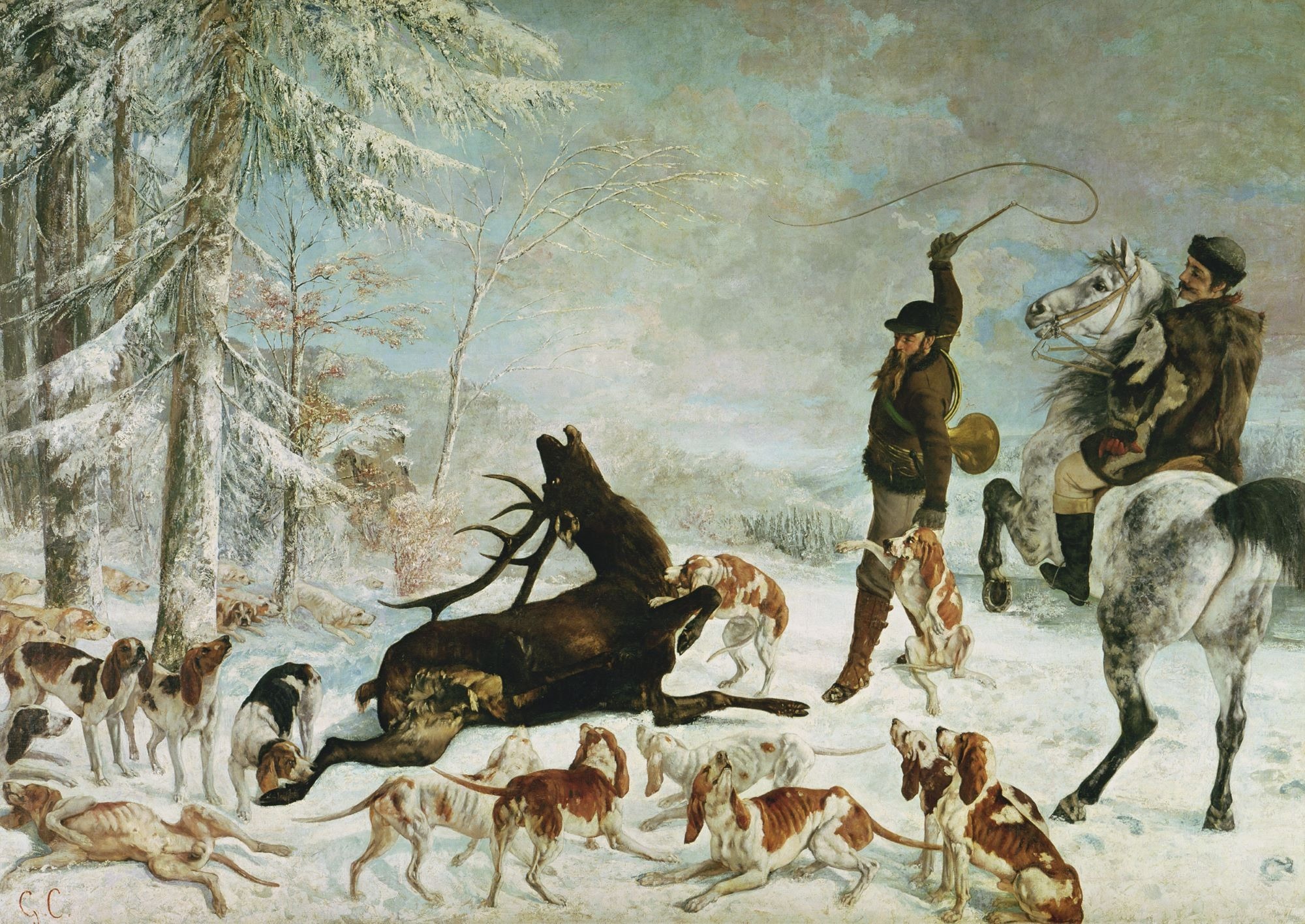Why do men love to hunt?

You have a struggling mammal in your mouth. You clamp your teeth into his wriggling furry warmness. Not good, oh no. All that squealing as the warm blood trickles down your chin. The terrified eye. You chew into silence. No, no, we don’t like to eat like this.
Our predatory nature is supported by the structure of our gut, 20 feet of small intestine to break down a (cooked) meat feast, in comparison to an ape’s intestines with a larger
colon, which deals with a primarily fibrous vegetarian diet. Weapons gave us strength, from club to spear to bow to gun. Pulling a trigger distances us, as do butchery, cooking, shopping and euphemism.
For the modern human (with a few exceptions) the necessity, craft, respect or indeed art of hunting for sustenance are history. It’s not economically viable. American hunters claim they hunt for food, but know they could dine on caviar in suits woven from mussel silk for what hunting costs them in kit, ammo, licences, time and travel.
So what is the pleasure, and where does it come from? The idea that human evolution has been influenced by our historical hunting behaviour is called the “hunting hypothesis”. The successful hunter got the girl, so passing on the killer traits that enabled him. But as much as hunting might explain the source of human aggression, there is a stronger case for cooperation. Our hunting history has been used as a rationale for strong male coalitions and gals staying home with the babies, for toolmaking and invention; more emphasis on hunt than gather.
Hunting that is not about sustenance is called sport. Once the pursuit of nobles, nowadays “bloodsports” are available to anyone who can afford it. The Spanish philosopher José Ortega y Gasset’s Meditations on Hunting sees hunting as a “vacation from the human condition”; “a hunter does not hunt to kill,” he writes, but “kills in order to have hunted.”
The hunter is alert, as animals are alert. A primal nature is restored in a divine rite where the hierarchy of man finds his rightful place. Yet Ortega y Gasset concedes that “reason” is “the greatest threat to the existence of hunting”.
For pure gratification, an animal who, let’s face it, wants to keep their life, must lose it. Lives with their own values, their own society, their own relationships, in their own wild world must be snuffed out. “Never stop and think or it will break your heart” is the advice from writer Vance Bourjaily, for hunting is natural and real and morality just a human construct. Killing solely for pleasure is difficult for others to understand. It works both ways, hunters say, eyeing our leather shoes.
In a Romanian guesthouse I came across the memoir of August Roland von Spiess. An Austrian officer born in 1864, von Spiess became a Romanian citizen and was appointed director of the Royal Hunts by King Ferdinand I in 1921. His memoir contained photographs that baffled the eye. Something contrary was going on. There was no apparent difference in the affection displayed towards the living or the dead. Alongside the predictable – Spiess with foot on dead boar, Spiess resting gun on roe deer – were photographs of the orphaned offspring taken in as family pets.
The most arresting and confusing photograph is when this is all happening at once: Spiess holding two live bear cubs while standing over a large dead bear with a dead dog laid on top of her, and a live dog leashed to her back leg. What was going on?
I found the answer at the Spiess hunting museum in Sibiu. On 25 January 1911, Spiess tracked a bear to a cave in the Laita Gorge, deep in the Carpathian Mountains. His favourite hunting dog, Hadubrand, was sent to investigate and all hell broke loose. A commotion of rabid snarling and roaring echoed from the cave until a sharp cry rang out. It hadn’t come from the bear. Spiess sent his reluctant assistant to investigate. When he returned, pale-faced, it was with the news that Hadubrand had been killed by a she-bear defending her cubs.
Spiess flew into a rage at the loss of his best dog. He made his way along the ledge with his other hunting dog, who tore into the cave. With a terrible howl the bear rushed at the entrance. Spiess fired and the cave filled with smoke.
As the smoke cleared, he could make out the dark hulk lying before him. He was astonished, knowing full well an unaimed close shot like that would normally result in a misfire – and probably a dead hunter. The account in the museum does not explain how Spiess brought back the two orphaned cubs, or what happened to them. Past the endless trophies and thorny antlers, I find the cubs’ mother. Her roar arrested for more than a century, her nemesis, the dog, beside her. The proximity seems vengeful.
What is it that over the centuries maintained such passion for the kill? Reverend David Cashman, Bishop of Arundel and Brighton from 1965 to 1971, was “mad about” shooting birds and mammals; he said it was the nearest thing to Heaven he knew. Reverend Charles Kingsley (1819–75), author of the children’s classic The Water Babies and a keen fox hunter, smitten by the sight of the swift grace of a fox, wondered if his quarry was a messenger of the gods:
“Who knows? Not I, I am rising fast to Pistol’s vein. Shall I ejaculate? Shall I notify? … Shall I break the grand silence by that scream which the vulgar call the view-halloo call? It is needless; for louder every moment swells up a sound which makes my heart leap into my mouth and my mare into the air…”
David Barrett is a British trophy hunter besotted with hunting. He has agreed to meet the South African-born cricketer Kevin Pietersen for the podcast Beast of Man. KP and radio presenter Sarah Brett interview him at his home, where African trophies stud the walls. KP is looking at a photograph of Barrett next to an elephant with a scarlet hole in his forehead. “To shoot an elephant is an awesome thing to do. A stunningly, stunningly awesome thing to do, which is why I did it,” Barrett explains. KP asks if he feels a kind of urge. Barrett concedes there is an urge. “The buzz you get is enormous … a tremendous buzz …” He tells Kevin he dropped the elephant in a full charge at 10 yards. “I paid a lot to shoot that elephant.”
Barrett is a “hunting person”, he says. A couple of years ago he shot a sable. “A stunningly beautiful animal … I mean it’s a very stupid animal. I only had to walk about 20 yards, and he stood and watched me the whole way there, and I actually felt quite guilty. I thought, You are dim; or he wanted me to shoot him, I don’t know which. So. Bang! Down he went.”
It’s “a bit rubbish,” the presenter suggests, “that you can only shoot stupid animals now”. Barrett agrees. He wants to find the right animal to shoot. Plan it. Shoot it. Wonderful!
“I love hunting, deeply, deeply, deeply,” he tells KP. “I used to get up in the morning and think, God, I’ve got to kill something today! … It’s what turns me on.” Barrett says he loves animals. That he feels an odd mixture of emotions. “I am honestly sad for that animal … and I’ll pat him on the head and say, I’m sorry, mate.”
But hunting is an armed and unprovoked intentional attack to kill a wild free animal with the odds stacked heavily in favour of it not killing you. This requires the attitude that an animal’s wild life is an expendable product. The sport is also governed by house rules. Each group must appropriate a mythology and wrap it in protocol, the right clothes, the correct lingo – which must be learned in order to become a member. Membership bestows a sense of entitlement to a stocked natural pantry, without any notion of its complex workings.
What other sport with weapons might satisfy these appetites, without spilling innocent blood and damaging the environment? How about fencing? It ticks a lot of the same boxes. Etiquette, rules, clubs, camaraderie. A display of manhood with sexy get-ups, frilly shirts, codpieces, flashy swords engraved with family crests, and lunging. That it is a highly skilled sport might count against it, but it could take place outside in flowery meadows with plenty of fresh air, followed by the same slap-up lunches.
Or could this ancient hunger be satisfied through a different way of intimately connecting to the creaturely world? To reverse the role from conqueror of the community to plain member of it? For having killed off so many species and animals throughout our history from overhunting, we now understand the vital roles they play in our ecosystems. With the recent emphasis on rewilding, and the reintroduction of species, such as wolves, that we once hunted, there’s a chance now to focus on bringing them back.
This edited excerpt from Keggie Carew’s “Beastly: The Epic 40,000-Year Story of Animals and Us” (Canongate) was included in New Humanist’s spring 2024 issue. Subscribe now.

